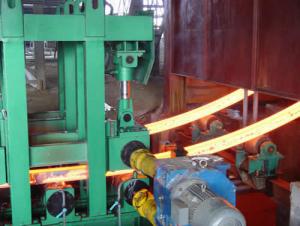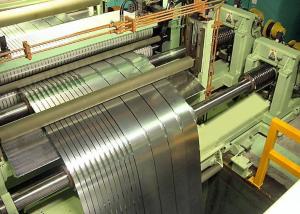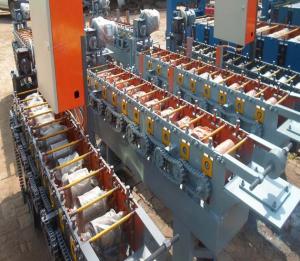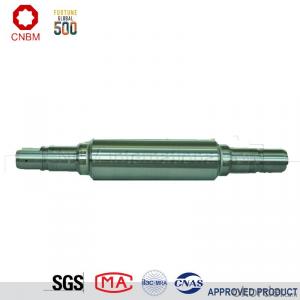Steel Continuous Casting Machine
- Loading Port:
- China Main Port
- Payment Terms:
- TT or LC
- Min Order Qty:
- 1 Set set
- Supply Capability:
- 30 Sets Per Year set/month
OKorder Service Pledge
Quality Product, Order Online Tracking, Timely Delivery
OKorder Financial Service
Credit Rating, Credit Services, Credit Purchasing
You Might Also Like
Technology process:
1.Heat the EVA film
2.Cover the heated EVA film on the mould(can be made from wood or aluminum)
3.Spray a coating in a certain baume degree
4.Put on the empty blask
5.Sand-up the flask and vibrate to compaction
Packaging & Delivery
Packaging Details:containers
Delivery Detail:Complete one set of equipment needs for three months
- Q: What are the different types of casting defects that can occur in centrifugal casting?
- Some of the different types of casting defects that can occur in centrifugal casting include porosity, shrinkage, inclusions, surface roughness, and dimensional variations.
- Q: How is the casting tested for pressure or leak tightness in metal casting machinery?
- Pressure or leak tightness testing in metal casting machinery is typically conducted using a process known as pressure testing. This process entails subjecting the castings to either internal or external pressure in order to determine their ability to retain pressure without any leakage. Various methods are employed for pressure testing, depending on the specific requirements of the casting and machinery. One commonly used method is hydrostatic pressure testing, whereby the casting is filled with a liquid, typically water, and pressure is applied to evaluate its tightness. This test involves pressurizing the casting above its anticipated operating pressure and examining it for any leaks or pressure drops. Another method is pneumatic pressure testing, where the casting is pressurized using compressed air or gas. Similar to hydrostatic testing, the casting is filled with air or gas and subjected to higher pressures in order to identify any leaks or pressure loss. In addition to these methods, specialized testing techniques such as vacuum testing can also be employed. Vacuum testing involves placing the casting in a vacuum chamber and reducing the air pressure to detect any air leaks. This method is particularly useful for identifying leaks in sealed or enclosed castings. Moreover, advanced technologies such as computerized pressure testing systems and automated equipment are frequently utilized to ensure the accuracy and efficiency of the testing process. These systems can monitor pressure levels, record data, and provide visual or audible alerts in the event of leaks or abnormal pressure readings. Ultimately, pressure or leak tightness testing plays a vital role in guaranteeing the quality and dependability of metal casting machinery. It aids in identifying potential weaknesses or defects in the casting, enabling necessary repairs or adjustments to be made prior to the machinery being put into operation.
- Q: How do you integrate castings into larger assemblies and structures using metal casting machinery?
- To integrate castings into larger assemblies and structures using metal casting machinery, various techniques are employed. One common method is through the use of precision machining, where excess material is removed from the castings to achieve the desired shape, dimensions, and surface finish. Additionally, castings can be welded or brazed onto other components to securely join them together. The casting machinery can also be modified to accommodate the specific requirements of the assembly, such as incorporating additional features or attachments. Ultimately, the integration process involves careful planning, precise execution, and thorough quality control to ensure the castings seamlessly fit into the larger structure while maintaining their integrity and functionality.
- Q: How do you optimize casting processes and minimize defects using computer-aided tools?
- Computer-aided tools can optimize casting processes and minimize defects by providing accurate simulations and analysis. These tools allow engineers to simulate the entire casting process, identify potential defects, and make necessary adjustments before production. By virtually testing different parameters such as mold design, gating system, cooling rates, and material properties, engineers can optimize the process to achieve optimal casting quality and reduce defects such as porosity, shrinkage, and misruns. Additionally, these tools enable real-time monitoring and control during actual casting, ensuring precise control over factors like temperature, pressure, and material flow. Overall, computer-aided tools enhance process efficiency, reduce trial and error, and ultimately improve the quality and yield of castings.
- Q: How does metal casting machinery handle the removal of casting defects?
- Metal casting machinery handles the removal of casting defects through various methods such as cutting, grinding, or sandblasting. These machines are equipped with specialized tools and techniques that help in removing any imperfections or unwanted elements from the castings, ensuring a high-quality end product.
- Q: What are the different types of gating systems used in metal casting machinery?
- There are several different types of gating systems used in metal casting machinery, each with its own advantages and applications. 1. Sprue: This is the initial channel through which molten metal is poured into the mold. It is typically large in diameter to allow for easy flow and is connected to the pouring cup or basin. Sprues help to minimize turbulence and allow for a smooth flow of metal into the mold cavity. 2. Runner: The runner is a passage that connects the sprue to the individual mold cavities. It distributes the molten metal evenly to each cavity, ensuring consistent casting quality. Runners can be straight or branched, depending on the complexity of the mold and the desired flow rate. 3. In-gate: The in-gate is the portion of the runner system that connects to the mold cavity. It controls the flow rate and direction of the molten metal into the cavity. In-gates can be of various shapes and sizes, such as round, rectangular, or tapered, depending on the geometry of the casting and the specific requirements of the part being produced. 4. Riser: Risers are additional cavities placed strategically in the mold to feed molten metal to compensate for shrinkage during solidification. They act as reservoirs, allowing extra molten metal to be available as the metal in the casting cools and contracts. Risers can be open or blind, and their size and location are determined by factors such as the size of the casting, the specific alloy being used, and the desired solidification rate. 5. Gate system variations: Depending on the specific casting requirements, there are various gate system variations that can be used. These include the use of multiple in-gates, hot-top systems, and bottom gating. Multiple in-gates are employed for larger or more complex castings to ensure balanced and controlled metal flow. Hot-top systems involve the use of an insulated reservoir on top of the mold, which helps to maintain the molten metal temperature during solidification. Bottom gating is used in gravity casting processes, where the molten metal is poured into the mold from the bottom to minimize turbulence and improve overall casting quality. It is important to select the appropriate gating system based on factors such as the size and complexity of the casting, the type of metal being cast, and the desired casting quality. The choice of gating system significantly impacts the final casting's integrity, appearance, and overall performance.
- Q: How is the ergonomics of metal casting machinery optimized?
- Various design considerations and ergonomic principles are utilized to optimize the ergonomics of metal casting machinery. These factors aim to create a safe and efficient working environment for operators while reducing the risk of work-related injuries. One crucial aspect of optimizing the ergonomics of metal casting machinery involves ensuring the appropriate placement and positioning of controls, buttons, and levers. The controls should be easily accessible and within the operator's reach to enable comfortable operation without excessive stretching or reaching. This helps minimize strain on the operator's muscles and joints. Another consideration is the design of the machinery's work surface. It should be set at an appropriate height and angle to promote a neutral body posture for the operator. This allows the operator to maintain a comfortable position without excessive bending, twisting, or reaching. Moreover, the work surface should be designed to minimize vibration and provide sufficient space for the operator to perform tasks. Furthermore, the design of metal casting machinery should incorporate suitable seating options. Ergonomically designed seats with adjustable features, such as height, backrest, and armrests, can greatly enhance operator comfort and support during long hours of operation. The seat should also have adequate padding and lumbar support to reduce the risk of back pain or discomfort. In addition to these design considerations, proper training and education for operators play a crucial role in optimizing the ergonomics of metal casting machinery. Operators should receive education on correct body mechanics, posture, and safe operating practices to minimize the risk of musculoskeletal disorders and other work-related injuries. Regular maintenance and inspections of the machinery are also essential to ensure optimal working condition. This includes checking for any signs of wear and tear, lubricating moving parts, and addressing issues promptly. Well-maintained machinery is less likely to cause discomfort or strain on the operator. In conclusion, the ergonomics of metal casting machinery are optimized through careful consideration of design elements such as control placement, work surface design, seating options, and operator training. By prioritizing operator comfort and safety, metal casting machinery can minimize the risk of work-related injuries and create a more efficient and productive working environment.
- Q: What are the different types of training and certification programs available for operators of metal casting machinery?
- There are several different types of training and certification programs available for operators of metal casting machinery. These programs are designed to provide individuals with the necessary knowledge and skills to safely and effectively operate various types of metal casting equipment. One common type of training program is offered by equipment manufacturers. These programs typically focus on the specific machinery produced by the manufacturer and provide in-depth training on its operation, maintenance, and troubleshooting. Participants in these programs usually receive a certificate of completion, indicating their proficiency in operating that particular equipment. In addition to manufacturer-specific programs, there are also industry-wide certification programs available. These programs are typically offered by trade associations or professional organizations within the metal casting industry. They cover a broader range of equipment and processes and aim to ensure that operators possess a standardized level of knowledge and skills. These certifications often require passing a written exam and demonstrating practical skills in operating metal casting machinery. Furthermore, there are vocational schools and technical institutes that offer comprehensive training programs for aspiring metal casting machinery operators. These programs typically provide a combination of classroom instruction and hands-on training, covering a wide range of casting processes, equipment operation, safety protocols, and quality control procedures. Upon completion of these programs, graduates may receive a diploma or an associate degree. Lastly, some companies may provide in-house training programs for their employees who operate metal casting machinery. These programs are tailored to the specific needs and requirements of the company and may focus on equipment operation, safety procedures, and quality control measures specific to their operations. Overall, operators of metal casting machinery have a variety of training and certification options available to them. Whether through manufacturer-specific programs, industry-wide certifications, vocational schools, or in-house training, individuals can acquire the necessary knowledge and skills to become proficient operators of metal casting machinery.
- Q: How is the casting removed from the mold in metal casting machinery?
- There are multiple techniques available in metal casting machinery for extracting the casting from the mold. One commonly utilized method is called shakeout, in which the mold is vibrated or shaken to loosen the casting. This procedure aids in breaking the bond between the casting and the mold material, facilitating easier removal. Another technique, known as knockout, involves the utilization of mechanical force to dislodge the casting from the mold. Hammers, mallets, or pressurized air can be employed for this purpose. The application of force helps to detach the casting from the mold cavity. In certain instances, the mold may include removable sections or parts referred to as cores. Typically made from sand or metal, these cores are utilized to create intricate shapes or internal cavities in the casting. Once the casting has solidified, the cores are extracted by either pulling them out or using techniques such as water pressure, air pressure, or mechanical devices. Furthermore, in specific metal casting processes like investment casting or lost wax casting, the mold is constructed from a material that is easily breakable or dissolvable. After solidification of the casting, the mold is intentionally destroyed, either manually or through chemical means, in order to release the casting. In conclusion, the method employed for separating the casting from the mold in metal casting machinery depends on the specific casting process being implemented and the complexity of the mold design. The objective is to safely and efficiently extract the casting from the mold while minimizing any harm to the final product.
- Q: What are the different types of molds used for lost foam casting in metal casting machinery?
- There are several different types of molds used for lost foam casting in metal casting machinery. These molds can vary in material, design, and complexity based on the specific requirements of the casting process. Some common types of molds used for lost foam casting include: 1. Polystyrene Molds: Polystyrene is a popular choice for lost foam casting molds due to its ability to easily vaporize when exposed to high temperatures. These molds are typically made by injecting molten polystyrene into a pre-designed mold cavity, which is then cooled and removed to create the desired shape. 2. Polyurethane Molds: Polyurethane molds are another commonly used material for lost foam casting. These molds are typically created by pouring a liquid polyurethane mixture into a pre-designed mold cavity. Once the mixture solidifies, the mold can be removed and used for the casting process. 3. Coated Sand Molds: Coated sand molds are often used for lost foam casting when a more complex or intricate shape is required. In this process, a mixture of sand and a binder material is coated onto a foam pattern. The coated pattern is then placed in a flask and packed with additional sand to create a mold. The foam pattern is then vaporized during the casting process, leaving behind a cavity that is filled with molten metal. 4. Ceramic Molds: Ceramic molds are commonly used for lost foam casting in high-temperature applications. These molds are typically made by coating a foam pattern with a ceramic slurry, which is then dried and fired to create a strong and heat-resistant mold. 5. Investment Molds: Investment molds, also known as lost wax molds, are another type of mold used for lost foam casting. In this process, a foam pattern is coated with a ceramic slurry and then dried. The dried mold is then heated to melt and remove the foam pattern, leaving behind a cavity that is filled with molten metal. These are just a few examples of the different types of molds used for lost foam casting in metal casting machinery. The choice of mold depends on factors such as the complexity of the desired shape, the material being cast, and the temperature requirements of the casting process.
Our professions include metallurgical technology, equipment and automation. We can provide the best solutions to the production process, design & manufacture of equipment and electrical automation regarding various industries in domestic and foreign districts with exquisite technology and fine quality service. We can provide all-around services to customers from development & design to the provision, installation and running of products.Strong technical strength, advanced equipment manufacturing technology, fine quality professional talents, and perfect service systems all bring about reliability, relaxation, convenience and delight to the cooperation with customers from beginning to end.
1. Manufacturer Overview
| Location | Jiangsu,China (Mainland) |
| Year Established | 2000 |
| Annual Output Value | |
| Main Markets | South America Eastern Europe Southeast Asia Africa Mid East South Asia Domestic Market |
| Company Certifications |
2. Manufacturer Certificates
| a) Certification Name | |
| Range | |
| Reference | |
| Validity Period |
3. Manufacturer Capability
| a) Trade Capacity | |
| Nearest Port | SHANGHAI |
| Export Percentage | 21% - 30% |
| No.of Employees in Trade Department | 3-5 People |
| Language Spoken: | English, Chinese |
| b) Factory Information | |
| Factory Size: | |
| No. of Production Lines | |
| Contract Manufacturing | |
| Product Price Range | |
Send your message to us
Steel Continuous Casting Machine
- Loading Port:
- China Main Port
- Payment Terms:
- TT or LC
- Min Order Qty:
- 1 Set set
- Supply Capability:
- 30 Sets Per Year set/month
OKorder Service Pledge
Quality Product, Order Online Tracking, Timely Delivery
OKorder Financial Service
Credit Rating, Credit Services, Credit Purchasing
Similar products
Hot products
Hot Searches
Related keywords
























